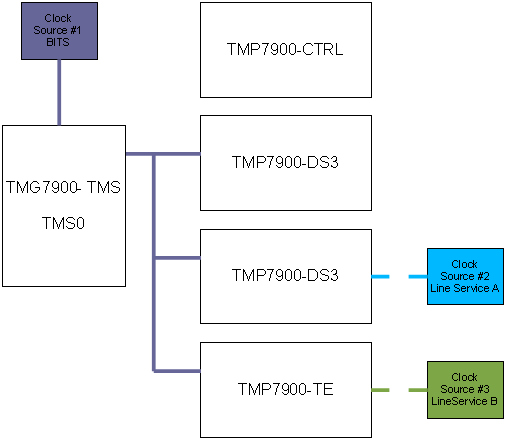High Availability:Hardware:Clocking
(underline title) |
(add precision for the clock selection scheme) |
||
| Line 10: | Line 10: | ||
Always place the most reliable clock source at the top of the clock references list. This will avoid unnecessary clock switch over. TelcoBridges recommend to synchronize the clock on the BITS port when available. If your system includes TMS1600, it is recommended to use the TMS1600 BITS ports as clock sources. | Always place the most reliable clock source at the top of the clock references list. This will avoid unnecessary clock switch over. TelcoBridges recommend to synchronize the clock on the BITS port when available. If your system includes TMS1600, it is recommended to use the TMS1600 BITS ports as clock sources. | ||
| + | |||
| + | When the system selects a clock, it will only use clock sources that are valid and that it is available on an active device of the system. For example, in a system containing 2 TMS1600 ( one will be active the other standby ) the clock sources on the standby TMS1600 (BITS ports) will not be chosen. In the figure below the clock source #3 and #4 won't be selected as system clock unless the standby TMS1600 becomes active. | ||
== Clock Redundancy == | == Clock Redundancy == | ||
| Line 18: | Line 20: | ||
=== <u>Recommended Setup</u> === | === <u>Recommended Setup</u> === | ||
| − | Here is an example of a system clock: | + | Here is an example of a system clock where 2 TMS1600 and the system has selected the clock source #1 as system clock: |
[[Image:Clocking_Ha_TMS.png|widthpx| ]] | [[Image:Clocking_Ha_TMS.png|widthpx| ]] | ||
Revision as of 16:35, 29 December 2009
The clock is a necessary component of a TDM network. Synchronizing your system on the right clock, allows it to offer good sound quality.
Contents |
Clock Sources
The Toolpack system can synchronized the system on 3 types of sources:
- BITS port (only available on TMS1600 and TMPx with DS3 or SONET/SDH mezzanine)
- Line Service
- SONET/SDH interface
Choosing Clock Reference
Always place the most reliable clock source at the top of the clock references list. This will avoid unnecessary clock switch over. TelcoBridges recommend to synchronize the clock on the BITS port when available. If your system includes TMS1600, it is recommended to use the TMS1600 BITS ports as clock sources.
When the system selects a clock, it will only use clock sources that are valid and that it is available on an active device of the system. For example, in a system containing 2 TMS1600 ( one will be active the other standby ) the clock sources on the standby TMS1600 (BITS ports) will not be chosen. In the figure below the clock source #3 and #4 won't be selected as system clock unless the standby TMS1600 becomes active.
Clock Redundancy
The system clock is configurred using the Toolpack web portal. Toolpack allow the system to have a system clock references list. Clock redundancy is accomplished by configuring at least 2 valid clock reference in the system. The system will scan through the clock references list until it finds a valid one. If the active clock source becomes unavailable, the system will scan through the clock reference list again to found another valid clock source. Clock recovery, which means that the system will switch back to a more preferred clock source if it becomes available again, can be configured in TMS network.
Another redundancy feature for the system clock is the 2 BITS ports which can be assigned to different clock source.
Recommended Setup
Here is an example of a system clock where 2 TMS1600 and the system has selected the clock source #1 as system clock:
References
NOTE:These refences assumes that your system is running Toolpack v2.3, if your system is running another version of Toolpack please select the appropriate Toolpack Web Tutorial Guide.
